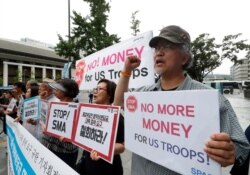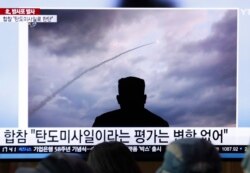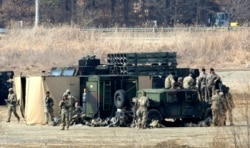Dialing back annual joint summer U.S.-South Korea military drills runs counter to North Korea’s continued missile launches and lack of denuclearization, said experts pointing to the computer simulation training unaccompanied by field combat exercises that is underway.
“If there were no North Korean threat, maybe I wouldn’t be as concerned,” said Bruce Bennett, a senior defense analyst at the Rand Corp.
“But North Korea keeps building its nuclear capabilities so they’re increasing their threat. They’re testing more missiles, which is increasing their threat. Scaling back the U.S. and South Korean preparations to deal with that threat doesn’t make a lot of sense,” Bennett continued.
North Korea fired two more missiles Tuesday, the fourth test in less than two weeks. This came just as the U.S. and South Korea began their annual joint military exercises that Seoul confirmed began Monday.
The U.S. has about 28,000 soldiers stationed in South Korea, and every year, U.S. and South Korean military forces conduct joint drills as they prepare to defend against potential attacks from North Korea. President Donald Trump said Wednesday via Twitter that South Korea “agreed to pay substantially more money to the U.S. in order to defend itself from North Korea” as its share of defense cost.
Following the launch Tuesday, North Korean leader Kim Jong Un said the country’s latest test of a tactical guided missile was a “warning to the joint military drills now underway by the U.S. and South Korean authorities,” according to a statement released Wednesday by the official Korean Central News Agency (KCNA).
Pyongyang also said Monday that the drills, which it sees as an invasion rehearsal, prompted the country “to develop, test and deploy the powerful physical means essential for national defense.” The KCNA statement said “a constructive dialogue cannot be expected at a time when a simulated war practice” is being conducted, although it said it remained committed to dialogue.
Bennett, who specializes in Northeast Asian military issues, said joint drills are a “fundamental part of the alliance,” and Kim’s objective is to “decouple South Korea and the United States” to get them to “abandon their alliance.”
Military officials are calling the drills “command-post training” this year in a move to avoid using the word “exercises,” which might provoke North Korea. The training is scheduled to end Aug. 20.
Bruce Bechtol, a former intelligence officer at the Defense Intelligence Agency and now a professor at Angelo State University in Texas, said that because the exercises are planned months in advance, the decision to exclude field training was not “done in reaction to the missile launches.”
‘Ramping up’ exercises
This year’s drills are not a proportional response to Pyongyang’s continued provocations and military buildup, Bennett said, because the Kim regime’s actions on denuclearization fail to match its words.
“They’ve done zero denuclearization,” he said. “They haven’t surrendered a single weapon. … Instead, they’ve been making more nuclear weapons.”
Bennett estimates Kim “roughly increased his nuclear destructive potential by 50%” since he promised to denuclearize in March.
“That doesn’t justify an end or a major suspension of exercises,” he added. “That instead says we ought to be ramping up our exercises.”
The U.S. and South Korean military trimmed back joint exercises after Trump began his summit with Kim in June 2018. At the Singapore Summit, Trump called for the suspension of “war games,” describing them as expensive and provocative.
The annual exercise dubbed Ulchi Freedom Guardian, usually scheduled for August, was canceled last year following the Singapore Summit. Foal Eagle and Key Resolve, the allies’ biggest annual spring exercises, were also canceled. The computer-simulation Key Resolve was replaced with the scaled-down Dong Maeng (which means alliance in Korean) in March.
David Maxwell, a former U.S. Special Forces colonel and current fellow at the Foundation for Defense of Democracies, said Pyongyang’s complaints about the joint drills reveal “Kim Jong Un’s hypocrisy.”
Maxwell said while the allies have significantly cut back the joint exercises in good faith, “the North has not responded in any positive manner, either with working-level negotiations or a reduction of its own offensive exercises in its winter and summer cycles.”
North Korea has about 70% of its combat forces deployed along its side of the demilitarized zone separating the two Koreas, Maxwell said, even as it protests allies’ exercises designed to defend against potential North Korean attacks.
Computer-simulated exercises
American and South Korean forces will exercise defensive war plans through computer-generated attack scenarios to enhance their coordination and “try to prepare to deal with North Korean threats,” Bennett said.
Multiple giant screens would display computer simulations of friendly and enemy forces as well as lots of maps, displays, tables and weather reports, among other things, that they would see in a real crisis, according to experts.
“The commanders and staff take the intelligence reports of enemy operations [based on intelligence knowledge of how the North Korean military would fight] and the status reports of friendly forces and fight the battles just as if they were real and there were actual troops on the ground and ships and planes at sea and in the air,” Maxwell said.
Bennett said, “The computer would take airstrikes that are ordered and adjudicate what the effects of those airstrikes would be ... on stopping an enemy offensive, for example.”
Crews operating tank simulators would see an enemy tank on the screen, Bennett said, and, “they could fire their tank rounds” that simulators would execute “as if they were in a real tank.”
What they learn from the training is then transferred to operating procedures of field combats, said Maxwell, adding computer-simulated exercises are “the most effective way to train commanders and headquarters’ staffs on the plans to defend South Korea.”
“This allows the commanders and staffs to train using multiple North Korean attack scenarios and lets them conduct training in two or three weeks that would normally take months if they were actually maneuvering full units on the ground, in the air and at sea,” he said.
Bennett said there are downsides, however, such as unexpected situations and coping with weather and physical terrains like details of rain or tanks slipping in mud that simulators might not capture like drills in the field would.
Nevertheless, Maxwell said, “even though the exercises appear to be scaled back, I have trust and confidence in [South Korean] and U.S. military leadership that they will conduct sufficient training in new, creative ways to sustain readiness.”










